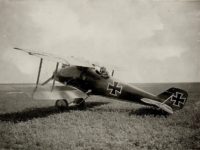The Roland D.II was the successor of the D.I, whose production was carried out after the fire of the company in Berlin Adlershof in Charlottenburg. The aircraft was more powerful and better armed, but could not keep up with the aircraft of Albatros and Fokker yet.
Development and construction:
Shortly after the start of production of the Roland D.I engineers Tantzen and Hoffmann began with the development of a successor plane. The special focus of the development was an increase in performance and the installation of a second machine gun.
As with the D.I, the D.II had a very aerodynamic structure, so that this aircraft was nicknamed "shark".
The first flight of the prototype took place in October 1916, after which the aircraft was presented to the German Army Command, who also issued a production order. In cooperation with Pfalz Flugzeugwerke in Speyer, around 300 aircraft were built.
The first series was equipped with a 160 hp Mercedes D.III engine, the second series was equipped with 180 hp Opel Argus As.III engines.
Use in the First World War:
Despite the increase in performance and the second machine gun, the Roland D.II could not keep up with the current Albatros aircraft. Thus, the few used on the Western Front aircraft were brought to less competitive sections.
Most of the aircraft were brought to and deployed on the eastern front or in the Balkans.
Technical specifications:
| Designation: | Roland D.II |
| Country: | German Empire |
| Typ: | Fighter plane |
| Length: | 6,93 meters |
| Span: | 8,94 meters |
| Height: | 3,11 meters |
| Mass: | 715kg empty |
| Crew: | Max. 1 |
| Engine: | Water-cooled six-cylinder in-line engine Mercedes D III 160 hp |
| Maximum speed: | 169 km/h |
| Reach: | 300 kilometers |
| Armament: | 2 x synchronized machine guns 7,92 mm LMG 08/15 |
You can find the right literature here:
Fokker Dr I Aces of World War 1 (Aircraft of the Aces)
Undoubtedly the most famous fighter type to see service on either side during World War 1, the Fokker Dr I was a revelation when it entered service on the western front in 1917. Manfred von Richthofens JG 1 circus was the first Jasta to completely re-equip with the new fighter, and in the skilled hands of its numerous aces the Dr I proved a formidable opponent. The Dr I remained in service on the Western Front until replaced by the superior Fokker D VII in May 1918. Just weeks prior to that, however, Germanys leading ace, the great Red Baron, had been killed at the controls of a Dr I.
Friedrichshafen Aircraft of WWI: A Centennial Perspective on Great War Airplanes (Great War Aviation) (Volume 21)

Friedrichshafen Aircraft of WWI: A Centennial Perspective on Great War Airplanes (Great War Aviation) (Volume 21) Paperback – February 16, 2016
This book describes and illustrates the development of Friedrichshafen aircraft of WWI with text, 540 photos, 18 in color, 37 color profiles, production quantities and serial numbers of aircraft, and aircraft dimensions and performance specifications. In addition, there are 26 official SVK drawings and 11 aircraft are illustrated in scale drawings to 1/48 (4) or 1/72 (7) scales. The book has 312 pages and is of interest to aviation historians, enthusiasts, and modelers alike.
German and Austro-Hungarian Aircraft Manufacturers 1908-1918
Much has been written about the British aircraft of the First World War, but little has surfaced about the aircraft of the Axis powers, Germany and Austria. Here, Terry C. Treadwell tells the story of the aircraft from companies such as Fokker, builder of the famous triplane, as fl own by Baron von Richthofen's Flying Circus, AEG, Albatros, Junkers and Hansa. From reconnaissance aircraft to state-of-the-art bombers that could reach London, this is the definitive guide to aircraft of the Axis powers during the First World War. The aircraft are explained in detail and a history of each company is provided, making this an excellent source book for aircraft enthusiasts, model makers and those interested in the air war over the trenches of France and Belgium, as well as further afield in the Italian campaign.
The Zeppelin in Combat: A History of the German Naval Airship Division
The standard reference now revised and expanded. Dr. Robinson has opened up his vast photo archives to enhance this new edition of his classic work. Much of the new photographic material is published here for the first time.
This post is also available in:
 Deutsch (German)
Deutsch (German)  Français (French)
Français (French)  Italiano (Italian)
Italiano (Italian)  简体中文 (Chinese (Simplified))
简体中文 (Chinese (Simplified))  Русский (Russian)
Русский (Russian)  Español (Spanish)
Español (Spanish)  العربية (Arabic)
العربية (Arabic)
















